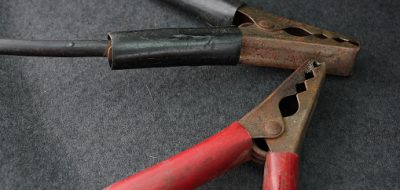Dear RV Doctor,
I have a 31-foot Southwind motorhome. Since I purchased the rig one of the 30-amp power cord prongs shows evidence of arcing. One prong is burnt looking with the rubber around it melted slightly. I replaced the male end but now the new plug is doing the same thing. Any idea on what is going on or what tests to run to find the problem? Also, I recently installed a PROsine 2.0 inverter and all seemed well with one large problem that I cannot run the air conditioner on the generator power. Shore power will run the air conditioner with no problems. When the air conditioner is turned on all AC power in the motorhome shuts off with a time delay of 1 to 2 seconds before coming back on. There was no problem running the air conditioner on shore or generator power prior to the installation of the inverter. I do not think there is a shore power/generator power transfer switch involved here because I have a separate female receptacle in the rear compartment that the power cord must be plugged into in order to get generator power.
–Daniel Stone, (Las Vegas, NV)
Answer:
Daniel, I’m thinking you have two separate issues; the first being the burned shoreline plug and the second being the inverter/air conditioning problem. The arcing shoreline plug could become a potentially dangerous situation so begin your troubleshooting with that one. Start by checking all the receptacles inside the coach with a simple plug-in circuit tester like the one shown here. Inexpensive testers are available at building and/or hardware stores as well as RV accessory stores.
With the coach plugged into shore power, plug the circuit tester into every wall outlet in the coach and verify the polarity is correct and that a good ground exists. Next, using a multi-tester or voltmeter, perform what RV technicians call a “hot skin” test. With the coach plugged into shore power, set the meter to AC Volts and attach the black probe to a good earth ground such as a water pipe, building ground rod, or other buried metal object.
Touch the red probe to several different metallic surfaces on the RV. If you get a voltage reading at any location you have a hazardous situation; a leakage of alternating current to ground. It may be necessary to have a shop perform an insulation breakdown test, also called a hi-pot test to determine if a short truly exists. Too much current is likely not the problem since the coach is protected by a breaker at the power pedestal as well as inside the coach. Even if one of the breakers is faulty, which is unlikely, it is highly unlikely that they both would be flawed.
The other possibility is a direct short. Although under normal circumstances, a circuit breaker will protect against a short circuit, there are cases where they simply might not. With the shore power cord disconnected, use an ohmmeter and make sure there is no continuity between either of the line prongs and the ground prong. I suspect that one of these tests will reveal a specific wiring problem in the coach.
In terms of the air conditioner problem, this may be a relatively simple issue. The inverter is capable of delivering 2,000-watts which is actually just under 17-amps at 120-volts AC. Obviously this is not enough to power the air conditioner which typically requires a dedicated 20-amp circuit. If we assume that the inverter was correctly installed, then it has been properly isolated from the converter and the converter has been modified, if necessary, to accommodate the inclusion of the inverter, thereby bypassing its own charge module. The PROsine inverter includes a charge module and automatic transfer switch.
The fact that the air conditioner causes the coach to lose power for a few seconds is indicative of the inverter trying to supply the power to the A/C instead of the generator being the voltage source. Simply what is happening is the inverter is going into over-current mode, shutting down and then resetting. This is likely caused by either a problem with the way the inverter is wired or it could be a generator output issue. It is possible that the inverter transfer switch is not sensing the generator output, although it is sensing the shore power. If this is the case, then the generator output is flawed, but since the A/C worked fine on generator power prior to the inverter installation, check that the installer didn’t inadvertently trip the genset breakers. It’s possible that what you believe to be the air conditioner not working off generator power is actually the generator not providing any output at all, where everything is trying to run off the inverter. That is until you turn on the air conditioner. Then, of course, the lack of available current shuts down the inverter. Check the circuit breakers located on the generator itself and see if they are tripped. It would be a good idea to have the generator output voltage and frequency checked by a professional as it is possible that the inverter is more sensitive to voltage and/or frequency than the air conditioner.
So it appears you may have two completely different, yet similar, electrical issues going on. It’s imperative that the above tests be performed properly and expertly to gain a clearer understanding.
(Please feel free to comment, however, please also note that due to the volume of communications I receive from multiple channels I cannot guarantee a personal response in every instance. However, questions of an overall general interest may be considered and published in an upcoming RV Doctor column.)





Pingback: ניסור בטון
Sarah Bloink
Hello,
I had this happen to me too, except that it shut down all the power in the trailer. We currently have no power, all the breakers are on, and we reset the GFI. We are trying to figure out how to fix it, as it is a permanent place, and the nearest camper repair shop is over an hour away. When I checked with the Ohmmeter with the shore plug, I got continuity with the top rod to the ground. But the rod on the right of the ground is the burnt one. Does anyone have any idea what we should check?
Thanks,
Sarah
Bill
RV Doctor – Electrical issues causing evidence of arcing.
It is important to make sure the breaker switch on the power pole is in the OFF position before plugging in. (If ON, then there can be a brief arc as the plugs come in contact due to the draw from the RV) Than, switch the power on.
Bill
Just my two cents worth.
If you are plugged into an extension cord of a lesser gauge than the coach you will have a high resistance thus causing a higher amperage draw by the coach. If the supply voltage is proper, either yours or the parks, this “shouldn’t” happen.
I had this problem from trying to keep plugged in through an orange extension cord. when I used a 30 A extension cord there was no heat at the plug.
Thomas Becher
If you had a male plug burn up then you also have the female plug burning up. I’ll bet its the same contact each time. If you plug into the same outlet all the time change it . You can’t do much about some campgrounds plugs. It’s a shame that there is no way to prevent plugging in while the breakers on which causes an arc which starts making a bad connection which just gets worse with each time something gets pluged into it. For your own safety get a tester, learn how to use it. Turn on the breaker, test, shut off the breaker if everything is good , plug in and then turn on the breaker. It’ll prevent arcing on your plug. Shut off breaker b4 pulling plug.
William Sartwell
I had the same arcing/burnt prong problem. And I, as the previous comment, resolved this by replacing Generator outlet….problem resolved.
Hope this was helpful. Good luck.
phil
If you had a partially melted AC plug it may have overheated when it was connected to the generator receptacle (if yours is wired like mine). If it is connected this, I would disassemble the receptacle & inspect wiring & connections to the receptacle.
Grampa Jim
I had that problem with the male end of my 30 amp plug,,,,and was surprised to find out that most of the receptacles in the Corps of Engineers park were outdated by about 30 years, and they were all making bad connections overheating the plug when I plugged in. No problems at all after the electrical contractor replaced the ones in question.
g.m.
Hmmm… I would check the wireing of the inverter if that was the last item that was installed. Take it to a different dealer that does the installation also…and have them check the other guys work.
I would almost bet you have ground wire issues and they may be cross wired at or when they installed the inverter. If not the inverter itself. By disconnecting it from the system you can then check the gen set and ac. The plug shows a lot of current being pulled if its arcing and burnt. This I think is the first clue that its not the gen set but rather the inverter wired into the MH. When your on shore power the gen set is not attached to the common on the plug… but can get a lot more amps from shore power than the genset can probably give. The 1-2 seconds delay with the power coming back on is the clue… something is tripping the ckt breaker for the mains… once that device overheats it takes itself off line and the mains reset … power comes back on… and contenues because the inverter is off line probably tripping its ckt breaker on and off but draws a lot of power when it tries to come on…. thus cooking your plug. I would start by testing the MH in/as turning off the inverter at its power switch… or unplug/ shut its main breaker off to it.. for the first test…..and then see how things work… if back to normal ops then you know its the inverter. The process is called shotgunning but it works sometimes…
Just my 2c